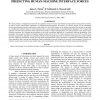Free Online Productivity Tools
i2Speak
i2Symbol
i2OCR
iTex2Img
iWeb2Print
iWeb2Shot
i2Type
iPdf2Split
iPdf2Merge
i2Bopomofo
i2Arabic
i2Style
i2Image
i2PDF
iLatex2Rtf
Sci2ools
BC
2002
2002
Linear combinations of nonlinear models for predicting human-machine interface forces
ACT This study presents a computational framework that capitalizes on known human neuromechanical characteristics during limb movements in order to predict man-machine interactions. A parallel-distributed approach, the mixture of nonlinear models, fits the relationship between the measured kinematics and kinetics at the handle of a robot. Each element of the mixture represented the arm and its controller as a feedforward nonlinear model of inverse dynamics plus a linear approximation of musculotendonous impedance. We evaluated this approach with data from experiments where subjects held a handle of a planar manipulandum robot and attempted to make point-to-point reaching movements. We compared the performance to the more conventional approach of a constrained, nonlinear optimization of the parameters. On average, the mixture of nonlinear models accounted for 0.79
| Added | 16 Dec 2010 |
| Updated | 16 Dec 2010 |
| Type | Journal |
| Year | 2002 |
| Where | BC |
| Authors | James L. Patton, Ferdinando A. Mussa-Ivaldi |
Comments (0)

